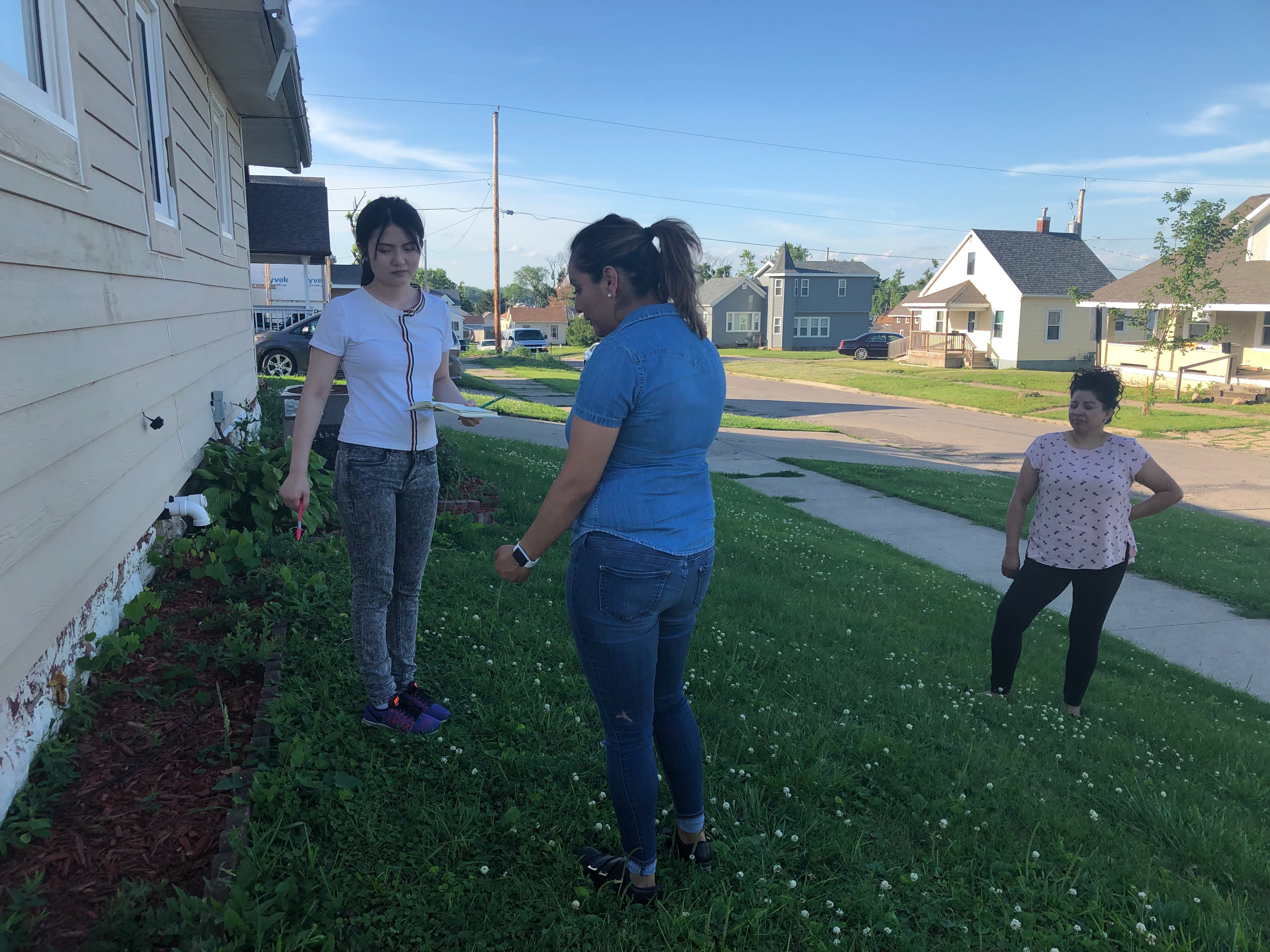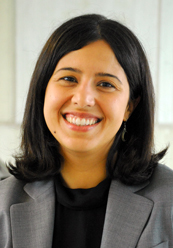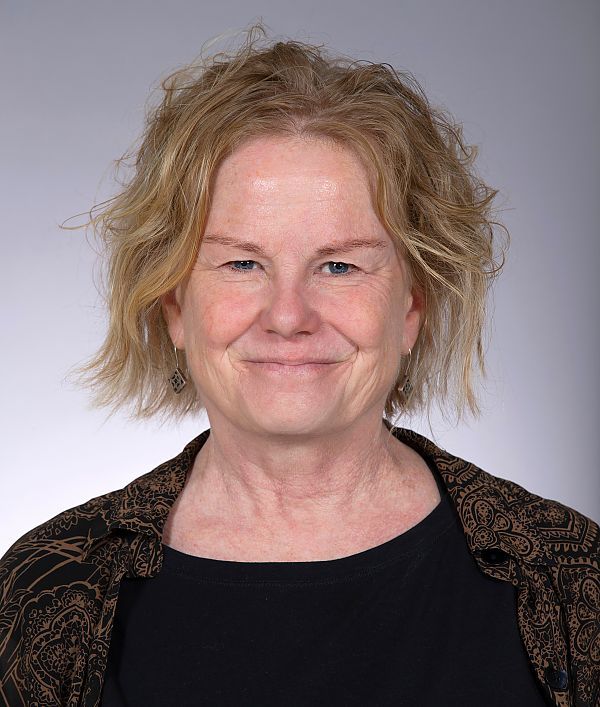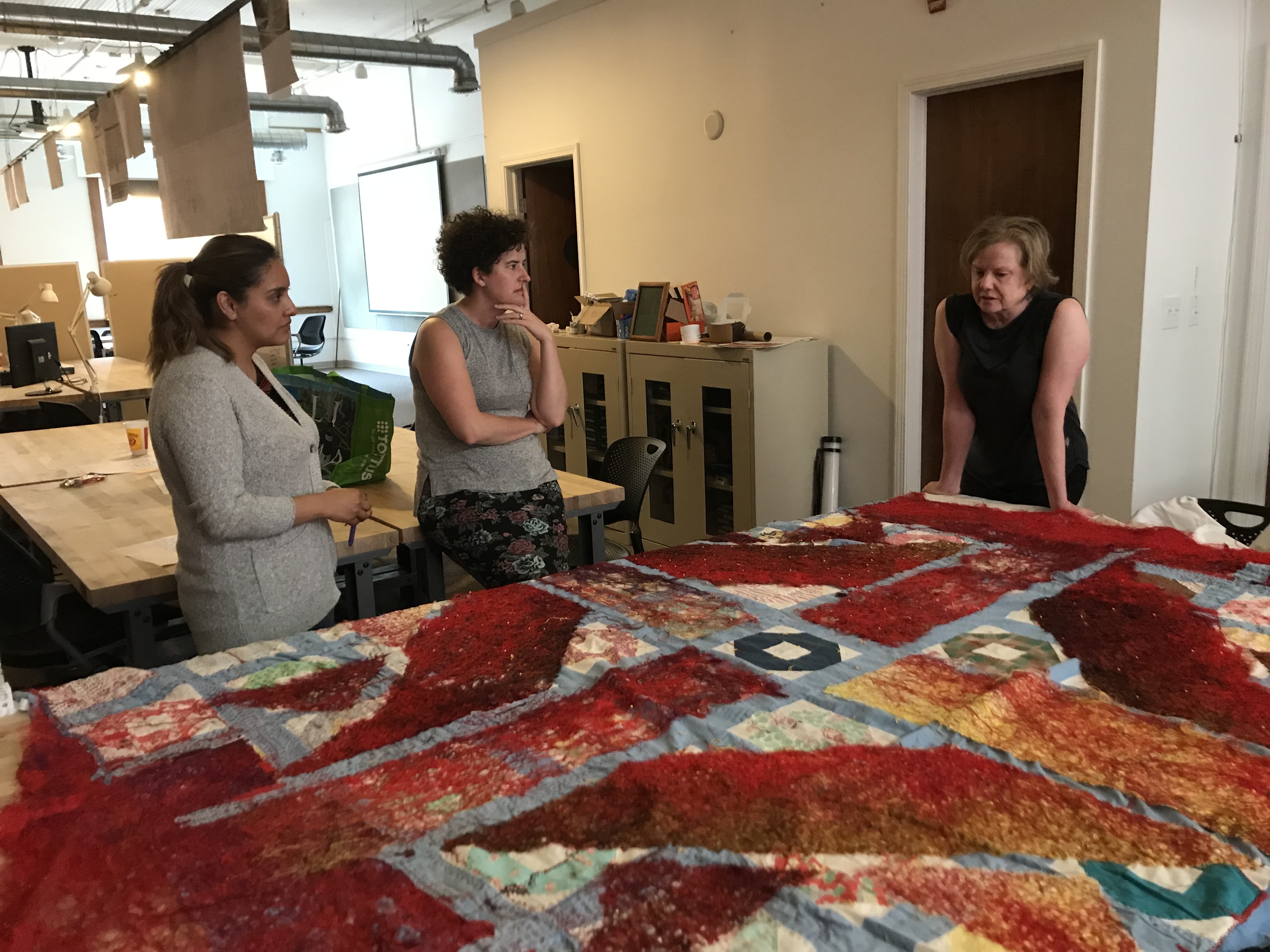
From left, Shuang Wu, graduate student in landscape architecture, and Jazmin Diaz, junior in management, survey Marshalltown residents about damages following an EF-3 tornado in July 2018. Photo provided by Mimi Wagner. Larger image.
MARSHALLTOWN, Iowa — Jazmin Diaz’s car was totaled a year ago when an EF-3 tornado struck her hometown of Marshalltown. Some of her friends lost their homes in the disaster.
A month later, Diaz, an Iowa State University junior in management, returned to school. Across campus, College of Design researchers started mobilizing to work with the community on recovery. This spring, Diaz joined a research project led by Sara Hamideh, assistant professor of community and regional planning, and Jon Wolseth, ISU Extension and Outreach community development specialist, to examine the housing recovery experience of different groups of Marshalltown residents.
“I was interested in helping because my community was so affected, especially Latinos,” Diaz said. “During our interviews with the residents, we saw the trauma. It goes so far beyond just the economic factors.”
In the months following the tornado, the effort expanded upon Hamideh’s research to include more faculty and students in Iowa State’s sustainable environments interdisciplinary graduate program. Mimi Wagner, associate professor of landscape architecture; Austin Stewart, associate professor of art and visual culture; Alex Braidwood, associate professor of graphic design; and Dave Swenson, associate scientist in economics, received a grant from the Fieldstead & Company Endowment for Community Enhancement Fund to support this year’s work in Marshalltown.
By the end of this fall, their goal is to finalize a toolkit that communities can use to examine social and economic challenges that exacerbate a disaster’s damage and slow recovery efforts. While other toolkits address disaster preparedness and response, the ISU researchers say this will be the first toolkit with regenerative and sustainable design in mind.
This spring, two sustainable environments courses taught by Wagner and Stewart joined the Marshalltown project. This summer, the same students are continuing the work in a course taught by Wagner. This fall, students in Braidwood’s class will finalize the toolkit. Wagner, Hamideh, Stewart and Braidwood also hold faculty appointments in the sustainable environments program.

Sara Hamideh
Research to help a community in recovery
Hamideh’s expertise is in disaster recovery and resilience. Last fall, her team surveyed households in the affected area and conducted detailed housing damage assessments. She is in the process of writing reports using the data gathered from a sample of 660 households to determine how different dimensions of social vulnerability influenced the amount of housing damage, the disruption to residents’ lives, their access to recovery resources and progress in repair and recovery. This research was supported by the University of Colorado Boulder’s Natural Hazards Center and Iowa State’s Hazard Mitigation and Community Resilience Program.
This spring, Hamideh and Wolseth received a National Science Foundation rapid research grant to build on her fall 2018 work. Hamideh and students conducted nearly 50 interviews with residents, primarily immigrants and non-homeowner households, including renters and those who have a contract sale. They also worked with community leaders to understand the experiences of residents affected by the tornado. Analysis of these interviews is underway.
“There is little data on experiences of immigrants and non-homeowners in the aftermath of disasters,” Hamideh said. “Part of the reason you don’t hear the voices of these folks in research is because it can be so hard to reach out to these populations. Some have been living in Marshalltown for decades, but they don’t speak English and therefore have limited access to timely information and resources. Similarly, when a disaster happens, renters don’t have much control over what happens to their houses.”
That’s why Diaz’s involvement was so important. Her intimate knowledge of Marshalltown, passion for her community and fluency in Spanish have been critical to every step in this research.
“These projects are so important to me,” Diaz said. “I want to create a better Marshalltown.”

Mimi Wagner
Listening to the community and taking action
This spring, Wagner’s and Stewart’s students conducted ethnographic interviews with 28 Marshalltown residents impacted by the tornado. They also led community engagement events at the Marshalltown Public Library, inviting residents to share ideas for Marshalltown and engaging with children through creative activities.
“We learned how difficult it was for them to begin recovery,” said Kelly Naumann, a graduate student in sustainable environments from Gilbert, Arizona, who was a student in Hamideh’s fall 2018 course and Wagner’s spring and summer courses. “Their routines were turned upside down.”
A recurring theme in residents’ comments was trees — so that’s what Wagner’s summer students are focusing on. They mapped the canopy cover and vegetation presence in the two neighborhoods in the tornado’s path before and after the storm, and found that at least 80 percent of the tree canopy was lost in the tornado.

Jazmin Diaz, junior in management, works
with Catherine Reinhart, Design on Main's
artist-in-residence, and Mimi Wagner.
Reinhart's community quilt repair project
is being considered for a Marshalltown
public art installation this fall. Photo
provided by Mimi Wagner. Larger image.
“Trees are important in all neighborhoods, across all sociodemographic factors,” said Jonathan Sherwood, graduate student in landscape architecture from Ames. “They provide shade, increase property values, provide a sense of place, reduce costs of heating and cooling, block noise and some pollution, create habitat for wildlife and improve human well-being.”
In the tornado’s aftermath, however, they learned that residents in lower-income neighborhoods were struggling to replant the trees they lost. This summer, the students are developing a “decision tree,” a tool to walk residents through each step of the tree planting process – a complex web of utilities regulations and local ordinances. They are also developing a brochure explaining the importance of a biologically diverse urban forest.
“We’re a year out from the tornado and there are still so many things that need to be addressed,” Naumann said. “The attention may have left after a couple of months, but the trauma remains.”
Diaz received an internship through Iowa State’s U.S. Latino/a Studies Program for this summer’s work with Wagner’s course. Swenson is assisting with economic analysis and insight into disasters from a policy and recovery perspective.
“This is what a land-grant institution is all about,” Wagner said. “Students are out there learning while also giving back to address community needs.”

